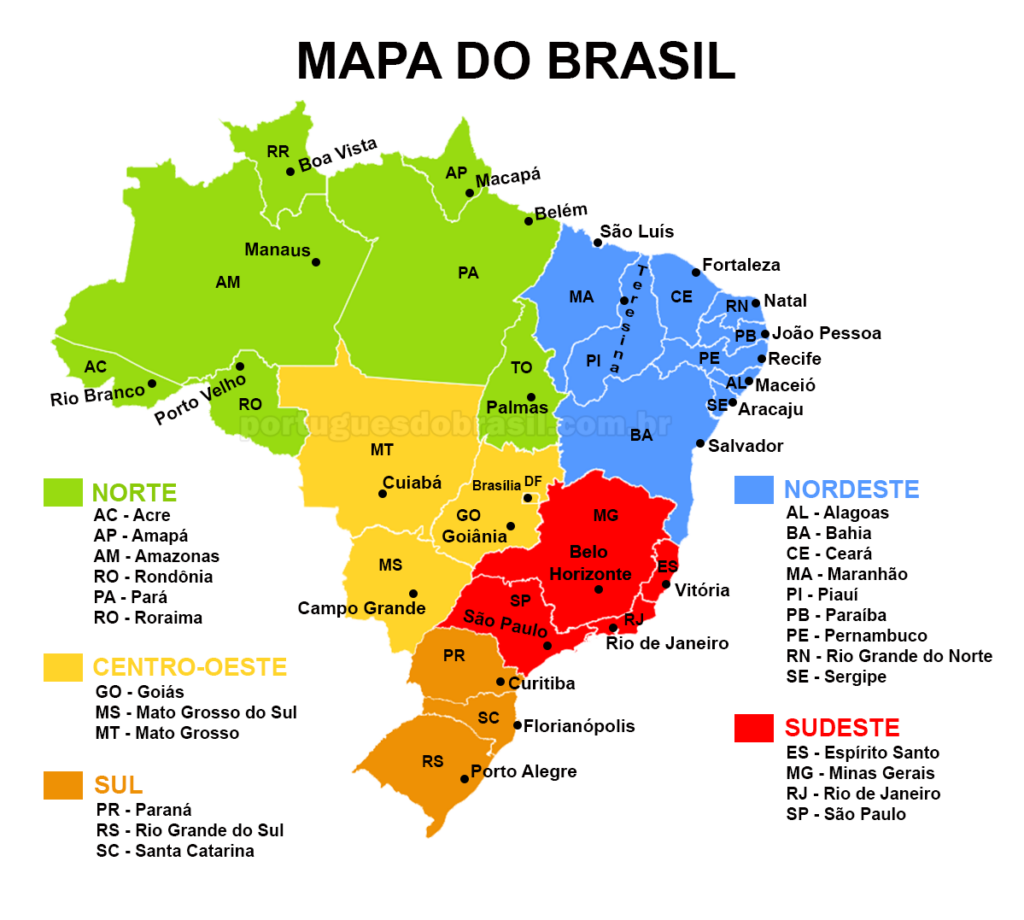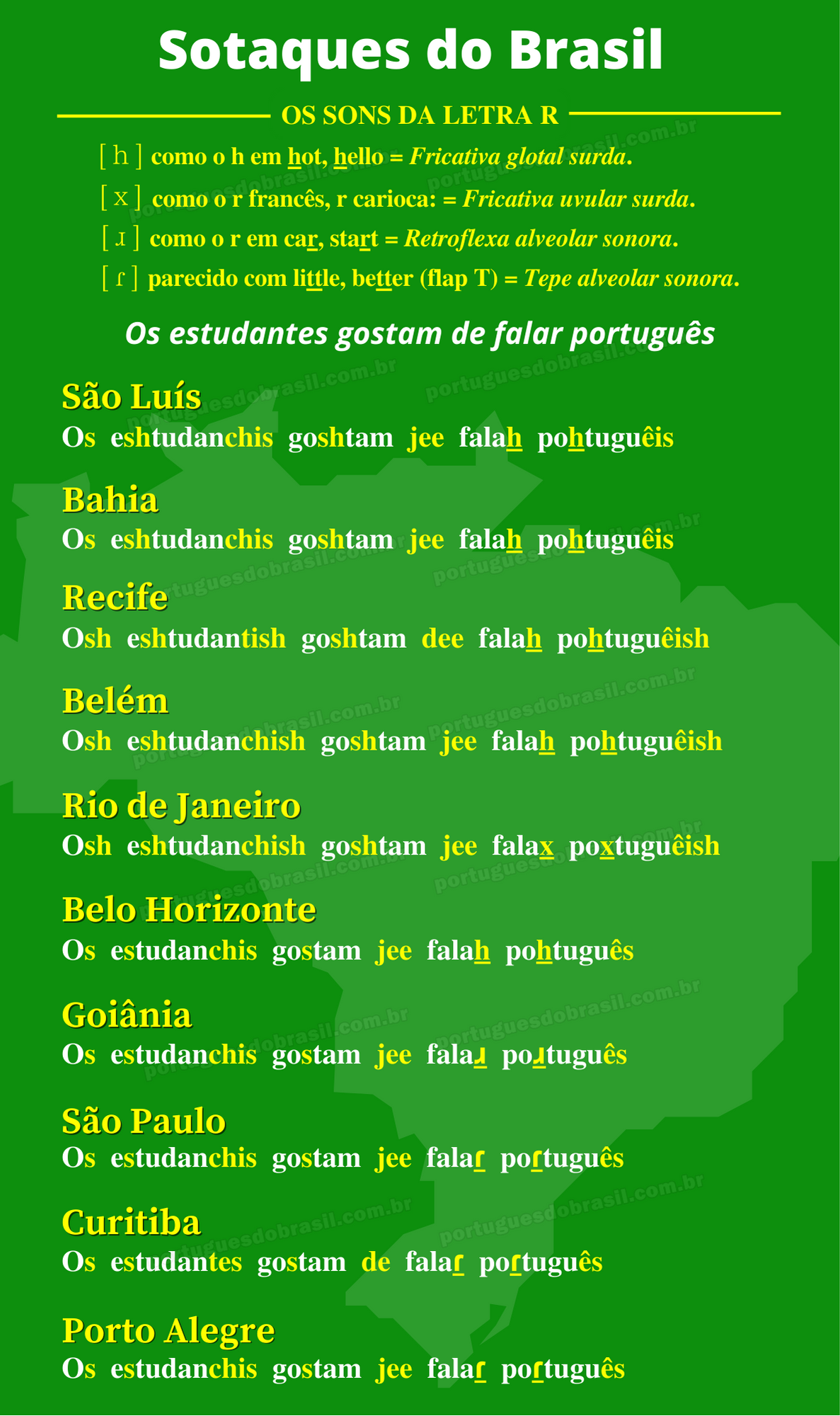The 10 Most Common Brazilian Accents Explained
Brazil is a country of vast cultural diversity, and this is reflected in its many regional accents. From the melodic tones of Salvador to the distinctive “chiado” of Rio de Janeiro, each region has its own unique way of speaking Portuguese.
Understanding these accents not only helps you recognize where someone is from but also also enhances your understanding of spoken Portuguese.
In this article, we’ll explore the most common Brazilian accents, uncovering their key features and what makes each one distinct.
1 – São Luís, MA.
To help you notice the differences between accents, I’m going to use this sentence as a reference: OS ESTUDANTES GOSTAM DE FALAR PORTUGUÊS (The students like to speak Portuguese).
Notice that in just one sentence, we have five letters that show the most sound variation in Brazilian Portuguese: T, R, E, D, S. These letters are largely responsible for the different accents found in Brazil.
In the São Luís accent, diphthongization is common, where a vowel turns into a diphthong. This happens often when a syllable ends with a vowel followed by S or Z.
So, português becomes portuguêis, vocês becomes vocêis, arroz -> arroiz, avestruz -> avestruiz.
Get used to this because diphthongization happens in many regions of Brazil. In São Luís, we speak like this:

2 – Salvador, BA.
The accent from Salvador is very similar to that from São Luís. Sometimes it’s hard to tell the difference between a baiano (from Bahia) and a maranhense (from Maranhão). We only notice the difference due to some details:
- The intonation of sentences.
- The use of some Baiano expressions, like painho (dad/husband), meu rei (my friend), and pocar (to succeed).

3 – Recife, PE.
People from Recife pronounce S as a SH sound, like in “shopping” or “wash.”
In phonetics, the symbol for this sound SH is [ʃ]. Here in Brazil, this sound is commonly called the chiado (hissing).
In English, chiar means “to sizzle.” So, when you hear that a Brazilian speaks with chiado, it means they pronounce the S with this sound.
But here’s a detail: this “S chiado” only happens at the end of syllables. A Brazilian would never pronounce Saturday as “shábado,” assault as “ashalto,” or know as “shaber.”
This way of pronouncing S also exists in other parts of Brazil, like Manaus and Florianópolis.
Many people in Pernambuco’s capital speak like this:

4 – Belém, PA.
At least 80% of Belém’s population speaks with a hissing sound. This is due to the heavy influence of Portuguese in Pará’s economy and politics.
The rubber boom in Pará, combined with the crisis in agriculture and fishing in Portugal, drove this migration in the second half of the 19th century.
Here are some other characteristics of the Pará accent:
Nasalization:
When a vowel, next to a nasal consonant in the following syllable, assimilates the nasal trait. This can happen within or at the end of a word. Examples: banana -> bãnãna, anel -> ãnel, família -> fãmília.
Palatalization of L and N:
This happens when a sound shifts its articulation point to the palate. In L and N, it happens like this:
L: galinha -> galhinha, família -> famílha, sandália -> sandálha.
N: menino -> menhino, ninho -> nhinho, júnior -> júnhor.
Use of pronoun TU:
Like people in Maranhão, those in Pará prefer to use the pronoun tu, usually with correct conjugation: tu vais, tu gostas, tu sabes.
Open mid vowels:
Examples: Verdade, coração, elefante, televisão.


5 – Rio de Janeiro, RJ.
The king of hissing in Brazil is Rio de Janeiro. Out of 100 Cariocas, 94 speak with “chiado”.
Besides the S, Rio’s accent has a unique characteristic: the R sound. It’s similar to the H in hot or hello, but stronger and longer, produced deep in the throat.
This way of pronouncing R and S comes from 1808, when the Portuguese court moved to Rio de Janeiro, fleeing Napoleon’s troops.
The Portuguese imitated the French R, like in Paris or marron. At the time, France was the cultural and intellectual reference in Europe, so speaking Portuguese with a French twist was elegant.
Locals adopted this way of pronouncing the French R and the Portuguese hissing S, which had always been a hallmark of European Portuguese.
That’s how the famous Carioca accent was born.

6 – Belo Horizonte, MG.
The most common accent in Belo Horizonte is:

Another way of speaking that you might hear in the capital of Minas Gerais is this:

Yes, the phonetic symbol for this consonant looks like an upside-down R. And this R is pronounced like the R in English, as in car and star.
It’s the retroflex R, and it doesn’t exist in European Portuguese—it only exists in Brazilian Portuguese! It emerged due to the difficulty that indigenous peoples in Brazil had in pronouncing the R of European Portuguese.
Note: In Minas Gerais, this retroflex R is more common in the southern region and the Triângulo Mineiro.
7 – Goiânia, GO.
Goiânia also has a strong presence of the retroflex R. The accents from southern Minas, Triângulo Mineiro, and Goiânia are very similar. You can only tell who is from Goiás and who is from Minas by their expressions.
This is Goiânia’s accent:

8 – São Paulo, SP.
São Paulo is one of the biggest immigration hubs in Brazil! Just to give you an idea, over 360,000 foreigners currently live here legally.
Additionally, it receives many Brazilians from all regions.
That’s why there are various ways of speaking and accents here.
After living here for many years, the most common accents to me are:


This vibrant R resembles the sound in little, bottle, better. It was influenced by Italian immigrants.
9 – Curitiba, PR.
The most characteristic sounds of the Curitiba accent are the consonants T, D, and the vowel E. This way of speaking is a legacy from European immigrants in the 19th century.
The immigrants who contributed the most to this accent were Germans, Ukrainians, and Poles.
But this influence was a long time ago. Nowadays, Curitiba receives more people from other parts of Brazil, so you’ll hear both “dente de leite and denchi de leichi.”
Another detail: people in Curitiba also pronounce the retroflex R.

10 – Porto Alegre, RS.
Another state with strong European immigrant influence is Rio Grande do Sul.
Because of this, Porto Alegre’s accent shares some features with Curitiba’s, such as the vibrant R and retroflex R.
However, the way people in Porto Alegre pronounce words ending in “te” and “de” is less marked.
So our reference sentence would sound like this:

I also notice that people from the countryside of Rio Grande do Sul have a very distinct intonation.
One final curiosity: there’s a commonality between the gaúcho and maranhense way of speaking: we prefer to use the pronoun tu.
São Luís: tu falas português?
Porto Alegre: tu falas português?






